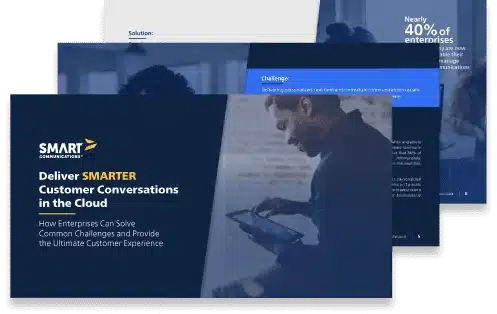Delivering Measurable Value: Move from Buzzwords to Bottom Line
By Eileen Potter, VP of Insurance Marketing at Smart Communications
In part one of my blog on the Gartner Report "Insurance CIO Priorities 2024: Insights for Technology and Service Providers' Product Plans," we focused on the key challenges facing CIOs this year, along with some of the digital initiatives that they are prioritizing.
CIOs recognize the need to use advanced technologies to remain competitive, enhance customer experiences, and drive innovation. And while the challenges might seem daunting, they also present an opportunity for innovation, and can empower insurers to overcome these hurdles and chart a course towards success.
In this blog, part two of the two-part series, we’ll delve into additional key areas shaping the strategies of Chief Information Officers (CIOs) in the insurance sector.
Deploying Generative AI
Insurance isn't a one-size-fits-all business. Today's customers expect personalized attention – including digital journeys – and relevant insurance products.
According to Gartner, “Forty-nine percent of insurance CIOs reported that they have already deployed AI/ML — which is not surprising, since early iterations of this technology have existed for some time. Basic chatbots, as well as computer vision, intelligent applications and natural-language-processing techniques are the AI techniques closest to early majority adoption, as insurers strive to improve customer service and operational efficiency.”
Data-driven Risk Management
Data is the new gold – but only if it's harnessed effectively.
Advanced analytics and data-driven insights are essential for insurance CIOs, highlighting the need for solutions that enable insurers to harness the power of data to optimize operations and drive business growth.
Embracing the Digital Ecosystem to Drive Growth
Creating a digital ecosystem enables the agility to evolve, so your organization can leverage emerging technologies, enhance product offerings, improve operational efficiency, and deliver personalized experiences – ultimately leading to expanded market reach and sustainable business growth.
-
API-driven Integrations: The report notes that, “New business models will demand greater connectivity with business ecosystem partners, as innovative insurers move from digital platforms to platform businesses. Open APIs hold the potential to expand an insurer’s reach to a broader audience, and to enable innovation and transformation by providing frictionless value exchange with business ecosystem partners.”
-
Cloud-based Collaboration: From the report, “Lead with “cloud-first” propositions for application modernization and articulate how their approach helps the insurer overcome excessive cost of change and insurmountable technical debt, and to build new cores that lay the foundations for digital business. Position services that help insurers overcome critical cloud skills gaps in the enterprise and to leverage rapidly evolving cloud technologies.”
Gartner Research shows that “Beyond AI, low-code/no-code is the only other emerging technology where more than 50% of insurance respondents reported they have either already deployed or intend to deploy in the next 12 months.”
Additional opportunities you should focus on include:
Identifying Generative AI Use Cases
The report states, “Generative AI has potential across the value chain for both internal and customer-facing use cases to improve document processing, customer self-service, marketing, data science, and operations such as claims, underwriting and product filings.”
Leveraging Data and Predictive Analytics
Advanced analytics and data-driven insights are essential for insurance CIOs to optimize operations and drive business growth. Additionally, data analytics can help insurers improve underwriting accuracy, detect fraudulent claims, and enhance customer segmentation strategies.
Continuous Improvement: Replacing Legacy Technology and a Legacy Mindset
Customer expectations are evolving, and insurance companies are recognizing the need to invest in technologies that enhance the overall customer experience throughout the policy and claims lifecycles. Hyper-personalized interactions will help foster loyalty in an increasingly competitive market. Modernized systems facilitate a more agile response to market changes, reduce operational costs, and enable better integration with emerging technologies.
Insurance CIOs must foster a culture of innovation and agility, indicating a growing demand for flexible and adaptive technologies that support rapid experimentation and iteration.
In conclusion, CIOs are set to encounter multifaceted challenges and opportunities in 2024. From digital transformation to talent management, the strategic decisions made by CIOs will play a pivotal role in shaping the future trajectory of the insurance industry. As technology continues to advance, staying ahead of the curve will be crucial for insurance companies looking to thrive in an era of unprecedented change.
Editor’s Note: This article is part two in a series of articles that highlight the key challenges for CIOs in 2024 inspired by insights from the January 2024 Gartner Report, "Insurance CIO Priorities 2024: Insights for Technology and Service Providers' Product Plans”. You can read part one here.
Gartner, Insurance CIO Priorities 2024: Insights for Technology and Service Providers’ Product Plans, By James Ingham, 2 January 2024
GARTNER is a registered trademark and service mark of Gartner, Inc. and/or its affiliates in the U.S. and internationally and is used herein with permission. All rights reserved.



